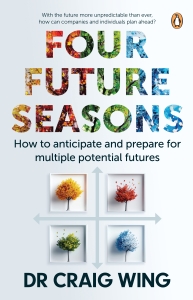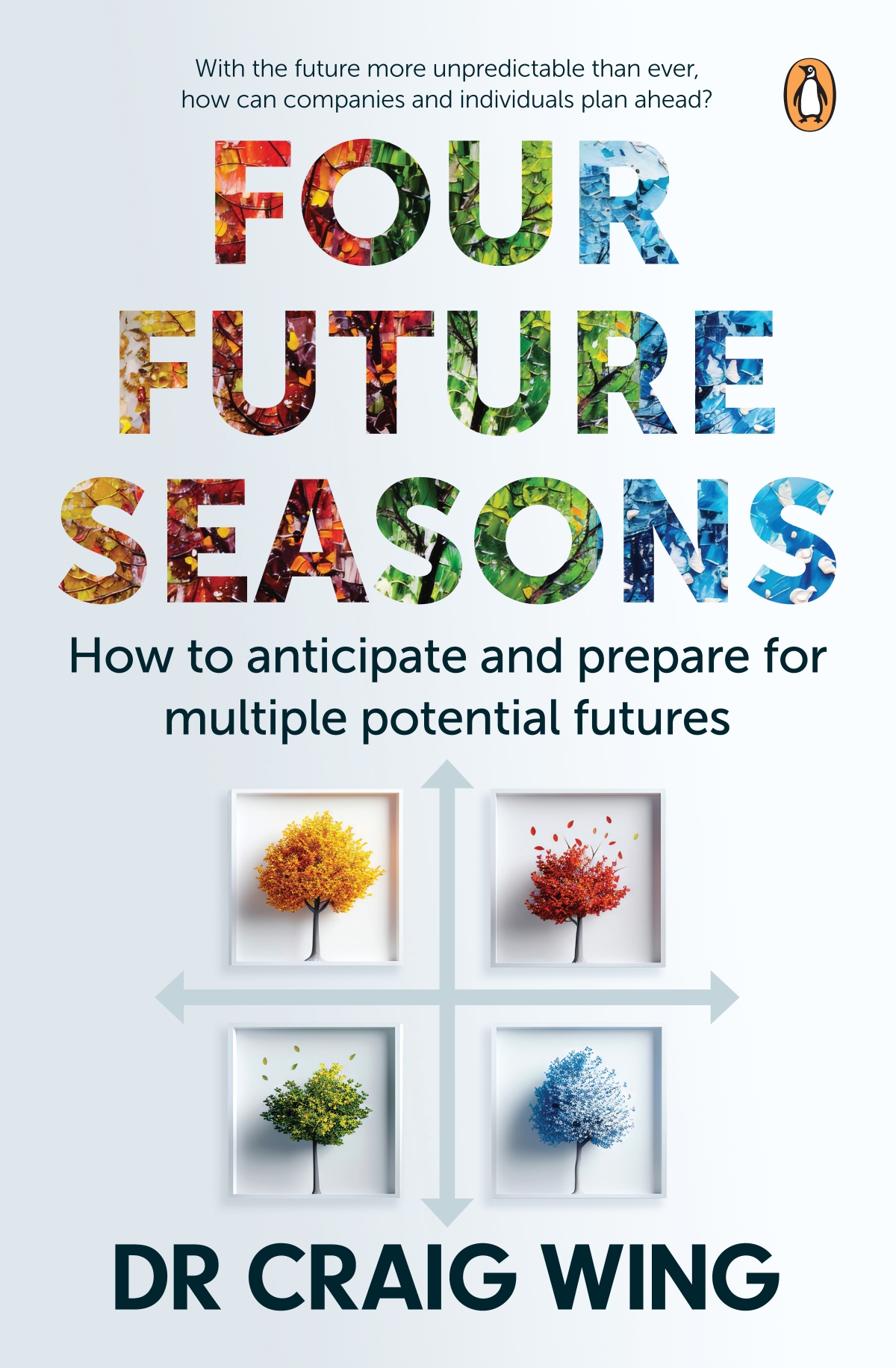
In an unpredictable world, traditional planning falls short. Four Future
Seasons by Dr. Craig Wing offers a dynamic approach to navigating
uncertainty, blending global expertise, research, and practical strategies.
Inspired by concepts like Rumsfeld’s ‘unknown unknowns,’ the Johari
Window, and Japanese seasonal wisdom, it helps readers anticipate
change and adapt with agility. More than a business guide, it’s for
anyone facing personal or professional challenges. Through stories
of resilience and innovation, Four Future Seasons equips readers
with the foresight and confidence to shape their future and thrive
in all seasons of life.
Booster Rockets and Horses’ Asses
The standard railroad gauge measures 1.435 metres, or 4 feet and 8.5 inches. This was not an arbitrary decision but was inherited from earlier tramway and wagon standards that were prevalent in England in the late 1820s.
Tramways, a precursor to modern railroads, used tools and jigs originally designed for wagon construction. These wagons, crucial for transportation in England, were built with wheels spaced 1.435 metres apart, as this specific spacing’s origins lay in the ancient roads of England, which bore deep ruts created by Roman war chariots. Dating back to imperial Rome, these chariots were standardised to ensure their wheels could fit within the established ruts without damage.
The width of the chariot was determined by the ‘propulsion’ of the time: horses, specifically the width of two horses’ derrieres! So, as British expatriates helped to construct the first US railroads, the standard width they set had actually been decided centuries earlier in England, from a width inherited from the Roman empire. The impact of such standardisation is made even clearer by noting that 60 per cent of the global 1 300 000 kilometres of railroads use the very same width.8 South Africa’s Gautrain likewise follows suit: a legacy of two horses’ asses – nothing to do with government.
The persistence of this gauge today underscores how historical practices and infrastructure decisions can endure over centuries, influencing technological standards far beyond their original contexts. Despite the evolution of transportation technologies and methodologies, the 1.435 metre gauge became entrenched as the standard measure for railroads in England and subsequently the United States. This intriguing historical narrative even extends to space exploration; from when the first operational steam locomotive was opened in 1804 until modern-day space travel, the width of two horses’ asses has been a critical determinant!
In the early days of the space race, rockets such as the iconic Space Shuttle Solid Rocket Booster (SRB) were manufactured by Thiokol in Utah. A pair of these boosters provided 85 per cent of the Space Shuttle’s thrust at lift-off and for the first two minutes of ascent, but after burnout they were jettisoned and parachuted into the Atlantic Ocean to be recovered, refurbished and reused. Elon Musk updated this approach, improving overall utility by reducing commercial waste and costs and paving the way towards privatised space travel.
The engineers designing the SRBs may have envisioned larger dimensions for greater thrust, but practical constraints intervened: SRBs were transported from their manufacturing facility in Utah to the launch site via railroad. This included navigating through mountainous terrain and passing through tunnels.9
One particular tunnel along this route had a clearance slightly wider than the gauge of the railroad track (approximately 1.435 metres). This clearance requirement, which had to accommodate two horses’ asses in ancient times, thus directly influenced the size and design of the SRBs. In other words, these boosters – critical components of one of the world’s most advanced transportation systems – were indirectly shaped by the dimensions set centuries ago by Roman chariots and horse-drawn vehicles!
This anecdote, a prime example of what Mulholland calls ‘legacide’, underscores how past processes and systems that have been entrenched can act as barriers, restricting our ability to innovate and explore new directions. These historical ‘railroads’ metaphorically constrain us, anchoring us to outdated norms and standards that shape our present and limit our potential for creating futures. They also determine how much we can innovate in a period of spring conditions. These are more than mere historical anecdotes; they speak to organisational practices that show how our adherence to antiquated standards can stifle flexibility and impede innovation. Even if organisations are able to identify nascent weak signals before they morph into black jellyfish, organisational legacide still constrains those organisations from taking action.
“They based their decisions on the assumption of a summer future that the internet was just a passing phase.”
This figurative comparison forces us to consider whether our approach to something is simply based on an entrenched idea or if it really is the optimal solution. In today’s digital age, for example, there’s a prevailing belief that digitising analogue processes (converting data into digital formats) automatically enhances efficiency and operational effectiveness. But the true potential lies not in superficial digitisation (the conversion of data) but in deep digitalisation: transforming entire processes and workflows to leverage digital technology. This distinction is crucial: digitisation alone risks perpetuating outdated practices under a digital facade, potentially exacerbating inefficiencies rather than resolving them.
In Chapter 4, I mentioned this same situation with a bank I was doing consultant work for. Although this example may seem outdated in today’s digital landscape, it was a critical issue when organisations first realised the importance of digitalisation. Historically, banking services were predominantly conducted in person, with customers interacting face to face with tellers, but the emergence of the internet in the early 2000s began to pressure banks to embrace this new technology. Initially, banks responded by creating a digital division, treating internet banking as just another channel to market; they didn’t foresee that internet banking would become the primary driver of their revenue, as it is today. Rather, they based their decisions on the assumption of a summer future that the internet was just a passing phase (there was no data or experience to show it would become the underlying driver of banking success) and so they ignored all potential signals. The rise of digital, neo- and challenger banks has since proven that traditional banking methods are no longer the norm and are now caught in a race to be relevant in a spring present.
Despite being ‘late to the show’ and recognising the internet’s potential for banking, many internal processes remained outdated. I recall a conversation with the CTO of this bank. He was enthusiastic about their digital strategy, a term frequently used by organisations worldwide, even today. The irony lies in the fact that digitalisation, rooted in the Third Industrial Revolution through automation with electronics and information technology, should already be commonplace as it started around the 1970s. Now, deeply embedded in the Fourth Industrial Revolution, the importance of digitalisation is even more pronounced, especially as organisations grapple with new disruptive technologies like AI, of which digitisation is a necessary building block.
The CTO was proud of their digital strategy and eager to explain it to me. Though this strategy was consumer-facing, the lessons applied universally. The CTO explained that their digitalisation strategy involved converting internal processes into electronic flows. Digging deeper, I discovered that the digital team had spent over a year converting customer onboarding documents – such as validation forms, applications and data gathering – from physical forms to digital Adobe equivalents. He was thrilled, believing this would leapfrog them ahead of traditional competitors and position them as a leading digital bank. Somehow, he couldn’t comprehend that making forms available online was not a digital strategy!
True digitalisation requires re-examining and reinventing core processes with the customer at the centre. It’s not about digitising flawed processes but about creating new, purpose-fit ones that truly enhance the customer experience. By merely adding a digital layer to a bad process, you don’t make it better – you make it worse.
Effective digitalisation entails more than just automating existing processes; it requires a fundamental rethinking and redesigning of workflows for the digital age. It demands innovation in how organisations operate and deliver value, leveraging technology to streamline operations, enhance customer experiences and drive sustainable growth. By embracing digitalisation, organisations can unlock significant opportunities to optimise processes, improve decision-making and achieve greater agility in responding to market demands.
Extracted from Four Future Seasons by Dr Craig Wing, out now.
YOU MAY ALSO ENJOY
Extract: Make Your Bed by William H. McRaven









